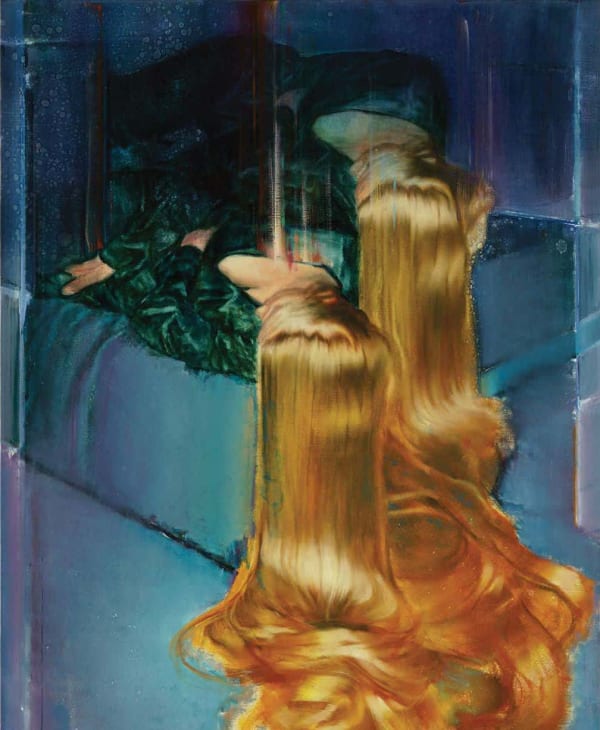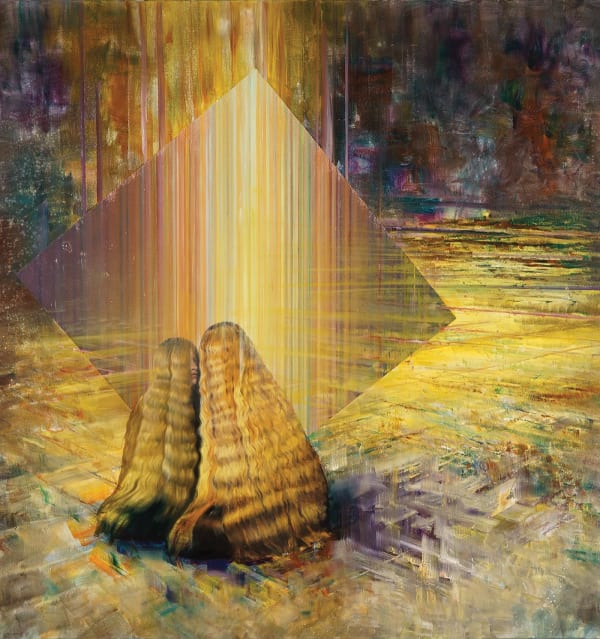Duplicated dreamer ... What can you say about this painting?
The "Duplicated dreamer" deals with one of life’s and painting’s most fundamental questions; what is reality, what is illusion and how they relate to each other.
Leaving space for the idea that life, and we are all three-dimensional projections of a multidimensional holographic matrix, the reality becomes as illusory as the dream from the point of view of wakefulness, and the old Buddhist saying “we are dreams of dreams” will make perfect sense.
The hair of a woman, lying on her back and hovering over herself, lives an independent life, forming a chaotic vortex, humbles down like a waterfall. This vortex has greater pictorial freedom and more open surfaces than the central part of the body and the painting, as do the overlapping, transparent vertical elements of the edges of the image. The variety of painterly surfaces fill the space with life. The color dynamics is formed by the predominant blue-orange complementary contrast, so that the color and space layers continuously overlap and flow into each other.
The process of painting is an act of meditation and at the same time it is a self-reflection. Although there are many different approaches, for me, researching the missing, having the freedom to give up is crucial. Let that be compulsively, or voluntarily, I often experience - virtually every work without exception - that I have some preconception about the work, which I then have to overthink and often give up. That is, I need to revise my own idea, which I thought was going to work, but in the process of painting I realized that I have to let it go and pay more attention to the now, to the present moment. This “participation in the process” inevitably involves surrender, often with a pronounced compulsion to forget. I have to forget my original plan, what originally started the process; raise awareness of my blind spots.
Double zero, 2021 - 2022 ... is it a kind of celebration? The end of something or the beginning?
Very good question, really. So much so that the term celebration has been racing through my brain for a long time during the title, but then I thought I wasn’t going to steer the viewer’s interpretation into a solid bed.
Part of the background story is that at a party celebrating the tenth year of a company’s existence, I saw the zero balloon obscuring each digit from a certain angle, unfortunately. The absurdity of the situation stuck in me and made me think further. By doubling the zero, I have further expanded the possibilities for interpretation, in addition to the fact that "something cooler than cool" can also be perceived as the eighth of the intersecting zeros, that is, as a sign of infinity. The uniqueness of human existence, its universality and its unrepentant spectacle are all part of the timeless space of painting.
When I deal with the work as a painter, it’s an amazingly liberating experience on one side. It takes my full dedication, but there is no guarantee that the process will end successfully. At most, I can pray that something will be created as a result of a state of grace.
What makes me very different from painting from all stills is the interactive relationship that is created during painting. That is, I do not carry out the work along with a preconception, but I have a suggestion, and during the creation I pay attention to what coincidences occur, which often give better ideas, and even allow the story to turn in a completely different direction.
There is no recipe, you can always slip away. But it is this risk factor that will keep the painting alive. The viewer also feels this vibration, my God, this could have been ruined. Our whole lives depend on a hair's breadth, and painting should be an analogy to this. You don't have a carabiner, that's the point.
I often say that there is no conceptual painting: there is conceptual art, and it has a raison d’être, but painting is basically not conceptual, because it has to be about the experience at the moment the work is born, it has to appear. Painting, by the nature of the medium, is beyond concept.
Empire of Midas, 2021. The hair became a central figure in your last works. This is a very strong painting, please tell us something about the idea of Midas in the painting.
Hair, as a painterly subject, has been the focus of my interest for years, partly because it is excellent for modeling virtual material and spatial experience from scratch, and partly because it sheds light on the quantumly fragmented yet homogeneous nature of our environment.
I have a degree in classical painting, perhaps this is why I like to play with art history as a whole, Meanwhile, it is also important to treat painting not only as a global but also as a universal system of relations, and of course all possible variants of abstraction. I want to fuse these layers within a painting, and assist the viewers to recognize that there is no big difference between these worlds. The other issue is that if any figure appears on an abstract surface, it immediately induces a much more complex system of relationships. The work will have wider connotations. I love to deal with this chaotic thing as a whole, not just the painting, but anything that may in some form contribute to newer insights.
The title of "Empire of Midas" was born somewhere halfway through work. As the shades of purple and yellow became predominant in the space of the painting, the whole thing seemed to receive a golden glow. It wasn’t part of the original plan, but I was convinced. It was then that the story of the legendary King Midas flashed to my mind, who in a thoughtless moment wished the god Dionysus to turn everything into gold from his touch.
How is an artist living in Budapest during these last two years? Is this “isolation” a change in your artist practice?
As a result of the pandemic, my work rhythm didn’t change much, the painter is just a lonely breed. I mean, I was alone in the studio during this period as before. In fact, honestly, I often miss my time alone. Of course, I missed meeting people in person or talking at openings. I have a daily rhythm, I take my daughter to school, I’m usually in the studio at 8am. Of course, this does not mean that I paint every day, there are a lot of extras in the work. Research on the computer, and a lots of reading, for example.
I see that some unavoidable changes are coming to our life. It’s hard to answer that, because I don’t know if it's just simply age-specific, whether my thoughts are due to my age, or perhaps is something brought on us with the pandemic.



